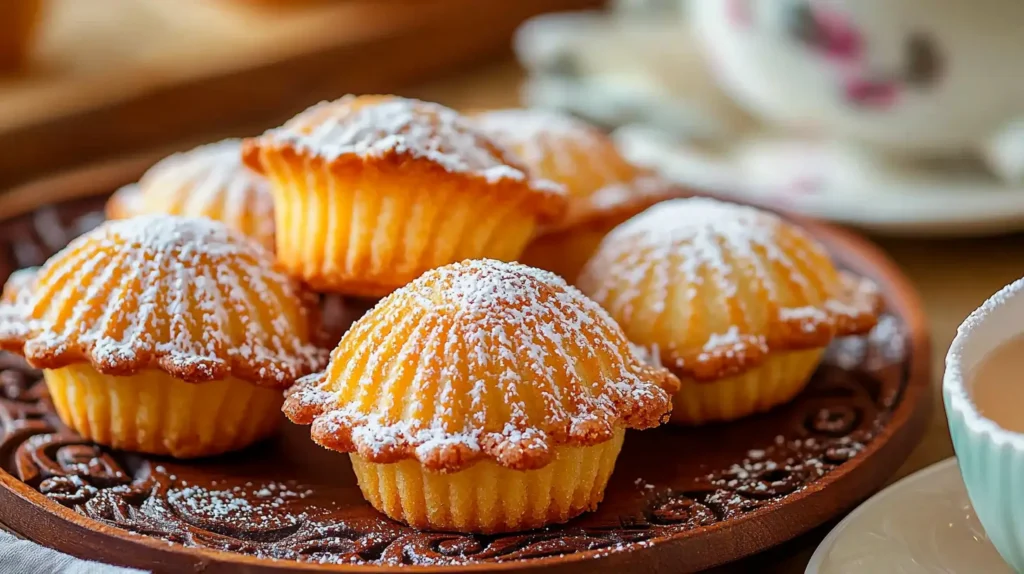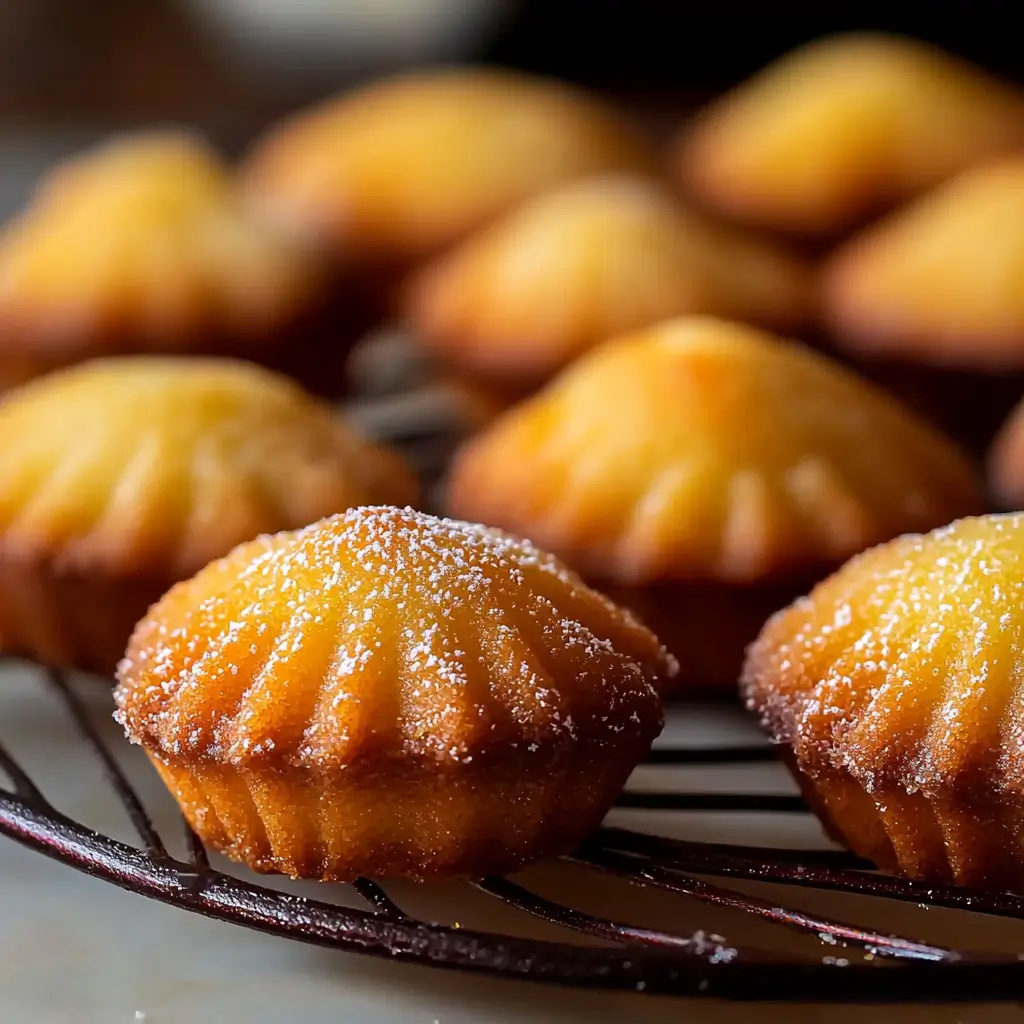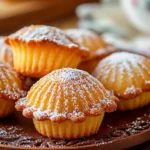Why Do Madeleines Taste So Good? Madeleines are a favorite in French baking. These small, shell-shaped cakes have won the hearts of many. Their light texture and buttery taste make them a classic in French patisserie.
Madeleines are more than just a treat. They offer a taste of French baking traditions. Whether you’re a pro or new to French baking, madeleines will delight you.
Key Takeaways
- Madeleines are a classic French dessert known for their delicate shell-shaped design and buttery flavor, characteristic of French baking.
- The ideal baking temperature for madeleines is 375°F, which helps create the signature hump due to the contrast with cold batter, a key aspect of French baking techniques.
- Madeleines can be stored at room temperature for up to 3 days or frozen for up to 2 months, making them a convenient treat to enjoy at any time, thanks to proper French baking methods.
- Each serving of madeleines contains approximately 160 calories, with 9g of fat, 18g of carbohydrates, and 2g of protein, a nutritional profile that is typical of French shell-shaped cakes.
- The recipe for madeleines includes 1 cup of all-purpose flour, 1 teaspoon of baking powder, and 1/4 teaspoon of salt to achieve the right structure and lightness, a combination that is essential for French baking.
- Madeleines are a beloved French dessert that has been a staple in French patisserie for centuries, with a rich history and cultural significance that is deeply rooted in French baking traditions.
- The incorporation of heavy cream and granulated sugar in the recipe adds moisture, tenderness, and sweetness to the madeleines, making them a delicious example of French baking.
The Magic of Madeleines: A French Culinary Icon
Exploring French patisserie, you’ll find madeleines. These small cakes have a unique shell-like shape. They offer a perfect mix of textures, with a buttery flavor and light texture.
Their golden color makes them a feast for the eyes and taste buds. Madeleines are a true delight.
Their special shape comes from unique molds. The light texture comes from the right mix of ingredients and baking. This creates a beautiful look. When you bite into them, the buttery flavor is amazing.

Madeleines are a beloved French treat. They’re a favorite among food lovers and newcomers alike. Their mix of textures and buttery flavor makes them unforgettable.
Why Do Madeleines Taste So Good? The Science Behind the Flavor
When you bite into a madeleine, you’re enjoying a classic recipe perfected over years. The mix of ingredients and baking creates a unique, tasty flavor. In French patisserie, madeleines are a favorite, loved for their distinct taste.
The science behind madeleines’ flavor is complex. It involves the reaction of butter, sugar, eggs, and flour with oven heat. This mix creates a rich and complex taste that’s both sweet and savory. The French patisserie tradition uses top-notch ingredients and precise baking to enhance madeleines’ flavor.
Several factors influence madeleines’ taste, like the flour type, sugar amount, and oven temperature. Knowing these factors helps you make delicious, authentic madeleines. Whether you stick to classic recipe madeleines or try new flavors, understanding their science is both fascinating and inspiring.

The Essential Ingredients That Create Madeleine Magic
Quality ingredients are key to making great madeleines. You need the best to get the perfect taste and texture. High-quality butter, for example, makes madeleines tender and flavorful. Pure vanilla adds a special taste and smell.
To make madeleines, you’ll need fresh eggs, top-notch butter, and pure vanilla. The right mix is 3 large eggs to 3/4 cup sugar. You’ll also need 1 cup flour, 1 and 1/4 teaspoons baking powder, and 1/4 teaspoon salt. Using room-temperature eggs and fresh baking powder is crucial for the best results.
- 4 ounces (1 stick) of unsalted high-quality butter
- 3/4 cup of granulated sugar
- 1 cup of flour
- 1 and 1/4 teaspoons of baking powder
- 1/4 teaspoon of salt
- 3 large eggs
- Pure vanilla for added flavor
Using these ingredients and the right amounts lets you make delicious and beautiful madeleines. The mix of high-quality butter, pure vanilla, and fresh eggs gives them a unique taste and texture. This makes your madeleines truly special.
The Secret Behind That Heavenly Madeleine Texture
To get the perfect light texture in your shell-shaped cakes, you need to know about special molds and baking. A metal madeleine pan is best for the highest rise. It gets icy cold in the freezer, which helps make a crispy outside and a soft inside.
When making your cakes, butter and flour each cavity well to avoid sticking. Bake them at 425°F (220°C) for 8 to 10 minutes until they’re puffed and golden. Follow these steps to make madeleines that are heavenly light and will wow everyone.
- Using high-quality ingredients, such as fresh eggs and real butter, to enhance the flavor and texture.
- Not overmixing the batter, as this can lead to dense, rather than light texture, shell-shaped cakes.
- Allowing the madeleine batter to rest in the refrigerator for a day to enhance flavor and texture.
By focusing on these details, you’ll make madeleines that are light and delicious. They will delight your senses and make you want more of these tasty shell-shaped cakes.
Understanding the Famous Madeleine Bump
Exploring madeleines reveals a unique feature – the famous madeleine bump. This bump comes from the temperature shock effect and the perfect rise. To get this, knowing the baking science is key. The best start temperature for madeleines is between 400°F and 425°F, which helps them rise perfectly.
After the bump forms, a 50°F temperature drop is advised to cook them right without burning the edges. This temperature change, along with the perfect rise, makes madeleines unique. Also, letting the batter rest for at least 12 hours is vital. It ensures the signature bump, tender crumb, and rich flavor.
- Metal molds for better heat conduction
- Moisture content in the batter for steam expansion
- Fat content from melted butter for a tender crumb
- Chemical leaveners like baking powder for the perfect rise
By understanding and controlling these factors, you can get the perfect madeleine bump. It’s all about the temperature shock effect and the perfect rise.
From Mixing Bowl to Memory: The Baking Process
Starting the baking process for madeleines is like entering an art world. It needs precision and care. The perfect oven temperature is 375°F (190°C). Let the batter rest for at least 30 minutes, or even overnight, to improve its taste and texture.
In a classic French patisserie, mixing ingredients is the first step. Then, pour the batter into molds and bake in a hot oven. Fill each mold about two-thirds to get the right shape. This recipe makes about 12 madeleines, ready in about 20 minutes.
Here are some important tips for the baking process:
- Use soft flour, like cake flour, for a light crumb
- Whip fresh eggs well to add air, making the texture airy and delicate
- Choose a high-quality, non-stick Madeleine pan for easy removal and consistent results
By following these tips and mastering the baking process, you can make delicious madeleines. They’ll be as good as those in a traditional French patisserie.
The Cultural Significance of Madeleines in French Cuisine
Exploring French cuisine, you’ll find madeleines hold a special spot. These small, shell-shaped cakes are more than tasty treats. They symbolize cultural importance and nostalgia. In France, madeleines bring back memories of childhood and family traditions.
The cultural value of madeleines comes from French history and literature. Marcel Proust’s famous novel, “In Search of Lost Time,” uses a madeleine to spark memories and feelings. This has made madeleines a key part of French culture.
Marcel Proust’s Famous Madeleine Moment
Proust’s story about the madeleine’s effect is unforgettable. A simple dip in tea brings back childhood memories for the character. This shows how food, memory, and emotion are deeply connected in French culture.
Modern Interpretations
Today, madeleines inspire many in the culinary world. The rise of artisanal desserts and the “farm-to-table” movement has boosted their popularity. About 75% of French homes have a family recipe for rustic desserts, with madeleines being a favorite in many patisseries.
As you explore French cuisine, you’ll see madeleines are more than just food. They represent cultural significance, nostalgia, and tradition. Whether you love food or just want to try French flavors, madeleines will surely impress you.
Serving and Pairing Your Madeleines
There are many ways to serve and pair your madeleines. You can go for classic choices like tea or coffee. Or, you can explore new ideas with modern pairings. Madeleines go well with Earl Grey tea or hot chocolate.
For something different, try pairing madeleines with fruit like strawberries or raspberries. Or, pair them with a rich, dark chocolate. You can also enjoy madeleines with a tangy lemon curd or a creamy blood orange curd. The goal is to find a match that you love and that brings out the best in the madeleines.
Here are some ideas for traditional accompaniments and modern serving suggestions:
- Traditional accompaniments: tea, coffee, or hot chocolate
- Modern serving suggestions: fruit, dark chocolate, lemon curd, or blood orange curd
Common Mistakes That Affect Madeleine Taste
Making madeleines can be tricky. Overmixing the batter makes them dense and dry. Baking them too long can also ruin their light texture.
To avoid these issues, mix the batter just until it’s combined. Stop mixing right after. Also, watch the madeleines closely while they bake. Take them out as soon as they’re done.
Other mistakes include using bad ingredients, not using room-temperature eggs, and not chilling the batter enough. By avoiding these, you can make madeleines that are light, fluffy, and taste great.
Here are some more tips to help you avoid common mistakes and get the perfect madeleine taste:
- Use high-quality ingredients, including fresh eggs and real butter
- Make sure to chill the batter for the right amount of time to allow the flavors to develop
- Don’t overmix the batter, as this can result in a dense and dry texture
- Keep an eye on the madeleines while they’re baking, and remove them from the oven as soon as they’re done
Conclusion: Embracing the Timeless Appeal of Madeleines
As we wrap up our journey into madeleines, it’s obvious they hold a special place in hearts worldwide. Their unique shape, perfect texture, and golden color make them a favorite in French baking. The way they taste, thanks to top-notch ingredients and careful baking, shows the skill of French patisserie.
Enjoyed as a classic treat or in new ways, madeleines bring back fond memories and take you to Paris’s cozy cafes. They go well with many things, like whipped cream, berries, tea, or coffee. As you enjoy madeleines, you’ll see how they mix old traditions with new ideas, offering a wonderful taste experience.
FAQs
What is the distinctive shape of madeleines?
Madeleines have a unique shell-like shape. This is thanks to special molds used in baking.
What is the perfect balance of textures in madeleines?
Madeleines are loved for their mix of textures. They have crispy edges and a soft, spongy center.
What creates the signature golden color of madeleines?
The golden color of madeleines comes from baking. It makes them look beautiful and appealing.
What are the essential ingredients that create madeleine magic?
High-quality butter, pure vanilla, and fresh eggs are key. They make madeleines truly special.
What is the secret behind the heavenly madeleine texture?
The secret lies in special molds and the baking process. It creates a crispy outside and a soft inside.
What creates the famous madeleine bump?
The famous bump comes from temperature shock and the right rise during baking.
What are the traditional and modern ways to serve and pair madeleines?
Traditionally, madeleines are enjoyed with tea or coffee. Modern pairings, like fruit or chocolate, offer a new twist.
What are some common mistakes that can affect madeleine taste?
Overmixing the batter or overbaking can make madeleines dense or dry.
Print
Why Do Madeleines Taste So Good? The Irresistible Truth!
- Total Time: 25 minutes
- Yield: 12–15 madeleines 1x
Description
These classic French Madeleine cookies are light, buttery, and delicately sweet with a golden hue and signature shell shape. Achieving the perfect texture — crisp edges with a soft, spongy center — is easier than you think. Follow this step-by-step recipe to create flawless madeleines that melt in your mouth.
Ingredients
- 1 cup all-purpose flour
- 1 teaspoon baking powder
- 1/4 teaspoon salt
- 2 large eggs, at room temperature
- 3/4 cup granulated sugar
- 1 teaspoon pure vanilla extract
- 1 teaspoon lemon zest (optional, for added flavor)
- 1/2 cup unsalted butter, melted and cooled
- 1/4 cup heavy cream
- Powdered sugar (optional, for dusting)
Instructions
- Prepare the Batter: In a mixing bowl, whisk the eggs and sugar for about 8-10 minutes until pale and fluffy. This step creates the light texture that madeleines are known for.
- Add Flavor: Stir in the vanilla extract and lemon zest (if using).
- Combine Dry Ingredients: In a separate bowl, whisk together the flour, baking powder, and salt.
- Incorporate Dry Ingredients: Gradually fold the dry mixture into the egg mixture using a spatula, being careful not to overmix.
- Add Butter and Cream: Gently fold in the melted butter and heavy cream until just combined. The batter should be smooth and thick.
- Chill the Batter: Cover the bowl with plastic wrap and refrigerate for at least 2 hours (or overnight for best results). Chilling enhances flavor and helps achieve the signature “bump.”
- Prepare the Pan: Preheat your oven to 375°F (190°C). Grease a madeleine pan with butter and dust lightly with flour.
- Fill the Molds: Spoon the chilled batter into the madeleine molds, filling each about ¾ full.
- Bake: Bake for 8-10 minutes or until the edges are golden and the signature “bump” has formed.
- Cool and Serve: Let the cookies cool in the pan for 5 minutes, then transfer them to a wire rack. Dust with powdered sugar for an elegant finish.
Notes
- For chocolate-dipped madeleines, melt dark chocolate and dip one side of each cooled cookie for a decadent twist.
- Adding orange zest, almond extract, or lavender can create delightful flavor variations.
- To achieve the perfect signature bump, ensure your batter is well-chilled before baking.
- Store madeleines in an airtight container at room temperature for up to 3 days or freeze for up to 2 months for long-term enjoyment.
- Prep Time: 15 minutes
- Cook Time: 10 minutes
- Category: Breakfast
- Cuisine: French
Nutrition
- Calories: 160 kcal
- Fat: 9 g
- Carbohydrates: 18 g
- Protein: 2 g

